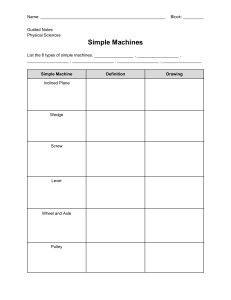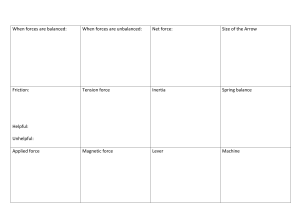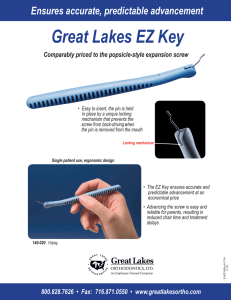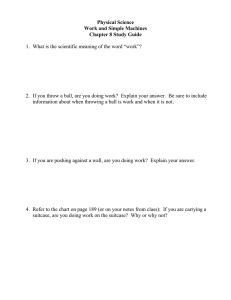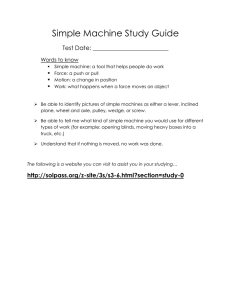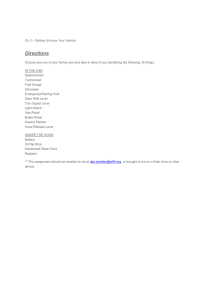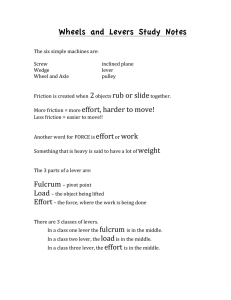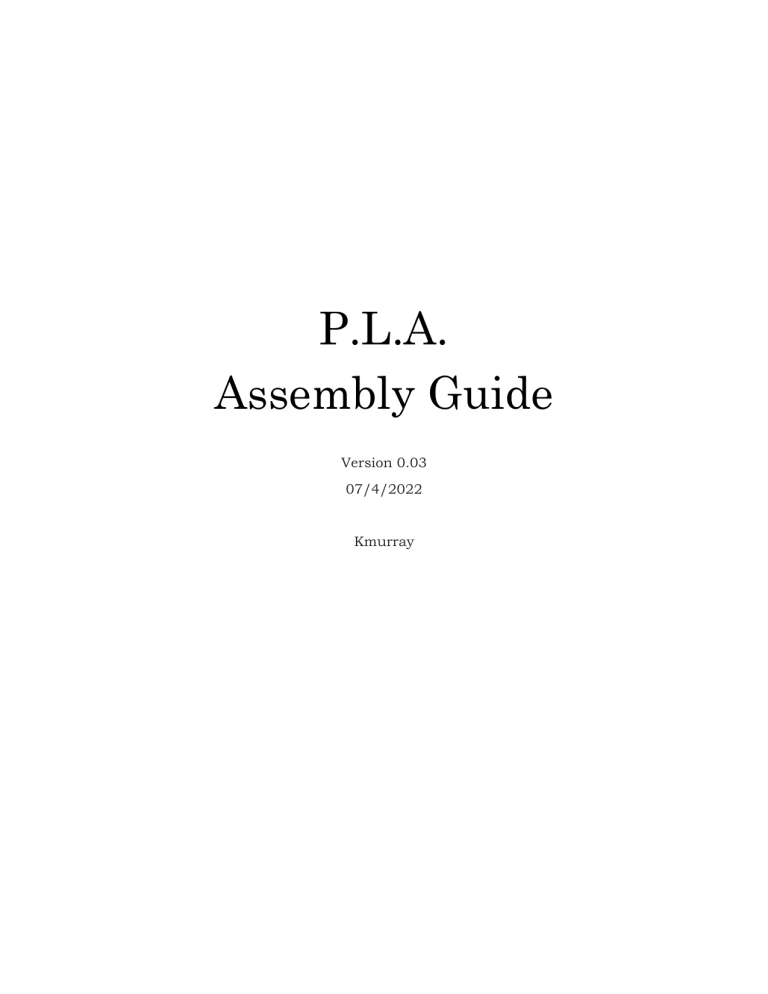
P.L.A. Assembly Guide Version 0.03 07/4/2022 Kmurray Contents Section №. 1: Introduction ………………………………………………… 3 Section №. 2: Tools …………………….…………………………………… 4 Section №. 3: Parts Kit Checklist ………………………………………… 5 Section №. 4: Assembly ……………………………………………………...7 Preparation ……………………………………………………………..8 Receiver and Tang ……………………………………………………..9 Barrel, mag tube, and taper pins …………………………………..11 Handguard and front sight …………………………………..……..14 Carrier assembly ……………………………………………………..17 Trigger and hammer assembly …………………………………….19 Lever and locking bar assembly …………………………………...22 Final Assembly ……………………………………………………….23 Section №. 5: Troubleshooting ………………………………………….…26 Section №. 1: Introduction It is with great pleasure we introduce to you our latest rifle: The P.L.A., or Plastic Lever Action. This .22 Caliber lever rifle is the finest and latest example of progress in gun making! You will find it to be an accurate shooter, reliable in action and strong in construction. From simple plinking to dusting varmints, whatever you do, nothing beats a P.L.A.! The P.L.A. is a 3D printable receiver for the Henry H001 lever actions in .22 S/L/LR. This lever gun uses a complete Henry H001 parts kit as well as an added M4 screw and nut and requires no special rails. This project was one of those “I wonder if I could do that” projects that came about after seeing a kit on EGP. As a result, this has become one of the first few 3D printed lever guns that one can make. Special thanks to @gerold_euerle on twitter for his help making this possible, and to AFriendOfLife for providing a name for the project. This design is in two main parts- the frame and the tang. The tang is integrated in the frame on the original Henry, but due to the 3D printing process, it had to be made separate to allow printing in a more ideal orientation. Because of this twopiece design, it’s able to handle the heavy spring used for the hammer without problem. Something to note though- the frame itself could not be made thicker due to very tight constraints within the receiver cover, so it relies a little more heavily on a good, tough print. Hopefully after reading through this guide, you should have a completed and working Plastic Lever Action of your own! Kevin Murray Section №. 2: Tools To assemble this firearm, you will need the following tools: - Assorted drill bits & drill Screwdriver(s) Punch Hammer/mallet The following tools are not required, but may help: - Needle nose pliers Section №. 3: Parts kit checklist To build your P.L.A. you will need the following parts specifically for the H001 lever action. Please note: assembling the bolt is not covered in this guide due to the fact that it often comes assembled in the kit already. Be sure you are getting parts specific to the H001 in .22S/L/LR. This frame has not been tested with/is incompatible with the H004 golden boy in any caliber, as well as the H001 in .22 Magnum and .17 HMR. This is only for the .22S/L/LR version of the H001. Original Parts A complete parts kit should contain the following: - Barrel Outer mag tube Inner mag tube assembly Handguard Barrel band and screw Front sight assembly w/ screws Carrier Carrier feed lever Carrier screw x2 Carrier spring and plunger Taper pin x3 Lever pin Trigger pin Locking bar pin Hammer pin Lever Trigger and trigger spring Locking bar and locking bar spring Hammer Hammer guide Hammer spring Bolt assembly Original Parts cont. - Cover Cover screw x4 Stock screw Stock Non-Original Parts These parts have been added to the design and are required in order to put this together: - M4 x 8 socket head screw x1 M4 nut x1 (Diagram referenced from Numrich’s Gun Parts) Section №. 5: Assembly In this section, we will cover the settings you should print your frame and assembling it. SAFETY FIRST Putting a gun together is no joke. Firearms are dangerous tools that must be treated with care and respect. You are responsible for your safety, and those surrounding you when you work with or operate firearms. Fellow developers or engineers cannot be responsible or liable for what you do or don’t do. As a general reminder, here are some rules to keep in mind: 1. Always treat a gun as if it is loaded. Remove the magazine and check the chamber yourself to verify the gun is unloaded. 2. Always keep your firearm pointed in a safe direction. Never point your gun at anything you do not intend to destroy. 3. Be aware of what is in front and behind your target. When working on your firearm, you should remember the following as well: 1. Keep live ammo away. Use snap caps or dummy rounds to verify function of your firearm. Never keep live ammo around your workspace, and certainly never mix them with your dummy ammo. 2. A clean gun is a safe gun. Never leave your firearms to foul or dirty up. Debris can cause malfunctions, which can be dangerous. 3. Always read and follow directions. Don’t ignore a warning or follow instructions out of order. Safety cont. 4. Use prudent judgement. If something doesn’t add up- use common sense. Stop, inspect, and re-evaluate your previous actions and procedures. Preparation Chase each hole with the proper size drill bit. This makes assembly easier and helps prevent cracking. Take caution not to oval the holes. Shown here is the hole for the locking bar which is being reamed out with a 15/64” (6mm) bit. Take a 13/64” (5mm) bit to the hammer pin hole as shown. Preparation cont. Use the same 13/64” (5mm) bit for the lever pin hole. Next, use a 1/8” (3mm) bit for the trigger pin hole. Sometimes it helps to carefully ream the taper pin holes out with the 1/8” (3mm) bit as well. Connect the receiver and tang Slide your tang and receiver together. It should look like this. Next place the M4 nut in the corresponding spot on the frame. (This is a cut down demo piece to show where it goes) Connect the two parts with the M4 x 8 screw. Barrel, mag tube, and taper pins Insert your barrel into the frame. It should be tight, so rotating it while installing may help this go easier. Don’t force it. Next make sure your barrel is lined up and insert your two taper pins from the right side of the frame. Carefully hammer your pins into place. This shouldn’t require a ton of force. Check your barrel alignment often as you do this because it tends to rotate when installing the pins. Usually it can be twisted back by hand before you put the pins in completely. This may take a couple tries to get right. Install your mag tube. Make sure this notch goes up towards the barrel when installing. The mag tube should be a relatively tight fit. Make sure it is aligned and tap it into place using a piece of scrap material. Note: If you are using the clamp style front sight, then you do not need to install the taper pin for the mag tube as it should be held securely with the front sight. Otherwise, install the taper pin for the mag tube just like with the barrel. Handguard and front sight Slide your handguard under the lip of the reciever. Next, slide your barrel band over your barrel and handguard. Insert the barrel band screw. Next take your front sight and use a flathead screwdriver or similar to insert into the bottom and hold it apart for installation. The sight hood can also be slid off to get it out of the way. Note the threaded hole in the barrel. This needs to line up with your front sight. Slide your front sight onto the barrel and mag tube. Line up the sight and install the top screw. Remove the spreading tool and install the clamp screw. Reinstall your sight hood if taken off. Carrier assembly Put the carrier spring and plunger into the carrier as shown. Set this aside for now. Take the carrier feed lever and install it into the frame. It should rotate freely. Some cleanup may be required in order for it to fit. Flip the frame upside down and slide the carrier into place. Make sure the spring and plunger go underneath the carrier feed lever. Hold the carrier in place and install screws. Trigger and hammer assembly Insert your trigger spring into the hole in the trigger. It may help to put some grease on the spring to hold it in. Put the trigger and spring into the frame. The spring should fit into the corresponding hole on the inside of the frame. Insert the trigger pin. Line up your hammer in the frame and put in the corresponding pin. Now pull the trigger, and push the hammer as far forward as it will go. Rest your spring and guide assembly in the hammer like this. Press the guide rod down with your thumb. The guide rod should slide into the tang. Hold the guide rod in place with your thumb, and use your other hand to pull the hammer back into the half-cock notch. Lever and locking bar assembly Install your lever and corresponding pin. Insert the locking bar spring into the frame. It helps to put some grease on the end to hold it in place. Now open the lever all the way. Put in the locking bar making sure the round lug goes underneath the lever. You will have to carefully press it down while you install the pin. Once the locking bar is in, check the function by opening and closing the lever. The locking bar should drop down when the lever is opened and pop up when closed. Final assembly Slide the bolt into the top cover making sure to leave some of it out like this. Open the lever partially and slide the cover and bolt onto the receiver. This can be tricky. Put in the four cover screws. Slide the stock into place. Hold the tang up and install the stock screw. Don’t forget to install your inner mag tube as well. Now you should have a fully assembled P.L.A.! Troubleshooting You may encounter certain problems with your firearm either during usage or assembly. Here’s some things that could go wrong and what to do: - Cartridges are jamming/not feeding properly o Make sure the carrier feed lever has been oiled Credit - General formatting and text for this document sourced from Vinh Nguyen’s DD43.1 build guide Henry parts diagram sourced from Numrich’s Gun Parts
